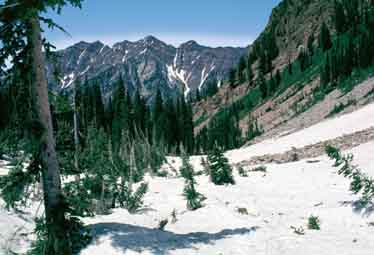|
Links to other sites:
Ordering books & Maps
Comments about this site or our book:

|
Located in the heart of Utah’s
Lone Peak Wilderness Area, Red Pine Lake definitely ranks among
the prettiest of the Wasatch Mountains’ high alpine lakes.
It is a popular day or overnight hike and you are bound to meet
many other trekkers along the way. If you are looking for more
solitude there are also several possible side trips off the main
trail that receive far fewer visitors.
From the parking area the trail
winds down a short distance to Little Cottonwood Creek, which
it crosses on a wooden foot bridge, and then proceeds at a gentle
upward slope along the east side of White Pine Canyon. The first
part of the trail is actually an old jeep road which was once
used by small-claim miners in the upper part of the White Pine
Canyon. The mining activity long ago proved uneconomical, however,
and today few signs of this piece of Little Cottonwood’s
history are evident. Vehicles are no longer allowed on the trail.
About a mile from the parking lot
the trail breaks out of the aspen trees to meet the water at
White Pine Fork, and at this point the Red Pine Lake trail branches
off to the right. Red Pine hikers must cross another foot bridge
to follow a smaller westward trail. The elevation at this junction
is about 8,040 feet, or 460 feet higher than the trailhead parking
lot.
Half a mile farther the path rounds
the ridge separating Red Pine Canyon from White Pine Canyon and
again bends to the south. At one point the terrain drops off
precipitously on the right, opening up a panorama of Little Cottonwood
Canyon. Tiny cars can be seen meandering up from the canyon mouth
on a gray thread of asphalt two thousand feet below, but after
a few hundred feet the trail ducks back again into the trees
and the brief contact with civilization is lost. The grade then
becomes somewhat steeper as the path climbs deeper into Red Pine
Canyon. Finally, at an elevation of 9,030 feet and a distance
of 2.5 miles from the trailhead, the trail reaches the creek
in the bottom Red Pine Canyon. At this point there is another
junction in the trail, with the path to Maybird Lakes crossing
Red Pine creek on the right. Red Pine Lake hikers should continue
straight ahead on the east side of the creek, but not before
pausing to appreciate the beauty of this spot. The forest now
has turned from aspen to conifer, and there is an abundance of
wildflowers along the grassy river bank-perfect for a short break.
Large patches of snow often lie
across the last mile of the trail, sometimes until mid-July.
This section of the canyon is well shaded on all sides except
the north and the snow seems to last forever. The path also gets
noticeably steeper near the top of the canyon, but finally, at
an elevation of 9,600 feet, it abruptly levels off. The lake
is a five or ten minute walk to the left from the top of the
canyon.
The setting of Red Pine Lake is
exquisite. The rugged crest that separates Little Cottonwood
and American Fork Canyons, as well as the Wasatch and Uinta National
Forests, lies just beyond the lake. Pfeifferhorn Peak (11,326
ft.) juts out prominently only a mile to the southwest, and to
the north, across Little Cottonwood Canyon, Dromedary Peak (11,107
ft.) and Superior Peak (11,132 ft.) are clearly visible. The
lake itself is about 600 feet across, with a smaller bay protruding
on the south end where the forest comes right to the water’s
edge.
Upper Red Pine Lake
Southeast of Red Pine Lake, 0.4
mile distant and 400 feet higher in elevation, lies Upper Red
Pine Lake. There is no established trail to Upper Red Pine, and
very little vegetation exists around the lake. The setting, however,
is spectacularly wild and rugged. The lake, which is about the
same size as its lower twin, lies directly beneath the dramatic
ridgeline. The best way to get there is along a small stream
which comes down from the upper lake to the southeast side of
Lower Red Pine. The route involves some scrambling over boulders
but is not technically difficult.
Maybird Lakes
As mentioned earlier, the trail
to Maybird Lakes leaves the Red Pine Trail about 2.5 miles from
the highway, or about one mile down from Red Pine Lake. The Maybird
Trail branches to the west, crossing Red Pine Fork on a narrow
wooden bridge just after Red Pine Trail first meets the creek.
It then follows a fairly level route for about 0.5 mile in a
westerly direction before turning south again for the assent
through Maybird Gulch to the three tiny Maybird Lakes. The first
lake is about 1.3 miles from the Red Pine trail junction at an
elevation of 9,660 feet, and the second and third lakes are situated
a quarter of a mile further up the gulch. The lakes are all small,
only 100 to 150 feet across, and the trees surrounding them are
stunted. The gulch is filled with the breakdown of the nearby
cliffs, and there is not enough soil to support a more luxuriant
forest. |
